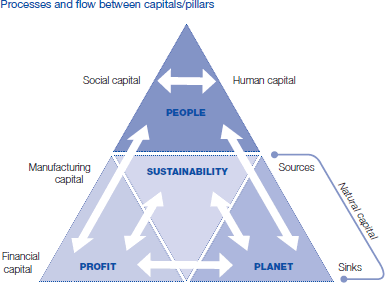The five capitals model of sustainable development was developed by Forum for the Future in the 1990’s. The model is used to show stocks and flows of resources as they relate to a sustainable society and economy. The purpose of this model is to illustrate the interconnectedness of various types of capital and the dynamic process through which organizations around the world can begin to achieve a balance between their environmental, social and economic needs. Below is a breakdown of the five capitals model and the importance of each part:

Natural capital:
Is the extension of the economic notion of capital (manufactured means of production) to environmental goods and services. Natural capital is thus the stock of natural ecosystems that yield a flow of valuable ecosystem goods or services into the future. Since the flow of services from ecosystems requires that they function as whole systems, the structure and diversity of the system are important components of natural capital.
Social capital:
Is the value added to various outputs of an organization by human relationships, and is generally referred to as the value of connections within and between social networks.
Human capital:
Is the stock of skills and knowledge embodied in the ability to perform tasks that are used to produce economic value. This capital is often accumulated through experiences and education.
Manufactured capital:
Is any physical means of production or means of protection beyond that which can be gathered or found directly in nature and often refers to goods, services, and infrastructures controlled by an organization.
Financial capital:
Is capital in the form of currency used by individuals and organizations to buy what they need to make their products or provide their services.
The five capitals model forms a basis for understanding sustainable development through the lense of the economic concept of wealth creation or ‘capital’. The distinction 'capitals,' detailed in the five capitals model is not a new concept. All organizations utilize these five types of capital everyday for the purpose of delivering products or services. Examining all sections of the five capitals model together, as a larger and collective unit, is where sustainability, stewardship and increased opportunity are realized.
Through discussion of this and other models of sustainable development, it is not the intention of KCX to indicate that the focus of our activities is on the promotion of any one model. Rather, by discussing various models we hope to acknowledge the value of sustainability as an aid to understanding future economic development around the world.
